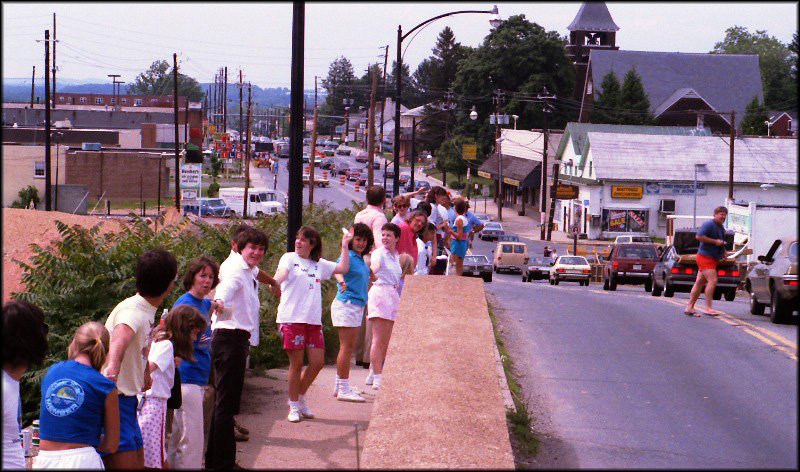
Last night was date night: vegan pasta at Pasta Pollo and a spontaneous decision to go see the movie Us, which we’d been wanting to see. I was blown away, quite honestly.
For one, I admire Jordan Peele’s work, most particularly his movie Get Out. I did not read any spoilers or theorycrafting for Us because I wanted to get my own thoughts, and here they are. (I will not provide a movie description–Google it!)
I was at first struck by the title of the movie. I thought immediately of Pink Floyd’s “Us and Them,” where, you know, if there’s an “us” there is usually a “them” because people tend to think in black and white that way. But what if “them” were really “us”, or there was no “them” because such dichotomies are based on fear, which is an emotion, not something that governs the universe. So everything in the movie was really just “us” with no thems, even though the movie tricks us into that old dichotemy.
And then, of course the movie may be seen as the country, the “US,” which is seemingly more self-obsessed than it used to be. When Adelaide asks Red who they are, these doppelgängers, she replies, “Americans.” All the cultural clues are there, so it makes sense.
At the beginning of the movie is some text about the many miles, thousands of miles, of underground tunnels, mine shafts, and so on under the soil of the United States. Places of abandonment, really. I first thought of the Underground Railroad. But hiding for a good reason is different than abandonment, at least sort of. Who are the doppelgängers? And why were they abandoned? I have no idea, but tend to see the movie as at least partially a way to recognize the shedding of our skins as we traipse through time and leaving the old “us”es behind. What if they/we are still alive though?
The Hands Across America thing is something I hadn’t thought of for a long time. It was a campaign in 1986 where a chain of people holding hands would cover America. This campaign was aligned with other initiatives like Farm Aid and Live Aid, with goals to raise money for people around the world struck with poverty and hunger. I think it was meant to show the diversity of people in America as well and how we could work–all of us together; for the movie to have this thematic tool to propagate the idea that difference is good was a fine strategy. In comparison, today with Trump as president in America, there’s a far different leadership that hastens divisiveness and wants to wall out people from other places. Kind of like the underground tunnels where the doppelgängers were forced to live behind a “wall,” and whose leader was trying to reproduce Hands Across America.
The 1980s feel of the movie struck me from the get-go, with the first scene engaged in a set with a 1980s television surrounded by shelves with videos (of the VCR type) like Goonies and Chud. It took me back to this other time that now seems sort of nostalgic but also foggy. 1986 was also the year of the Chernobyl nuclear disaster and the year that the space shuttle Challenger exploded slightly over a minute after launching, killing all seven astronauts on board. Smoking was banned in the U.S. on all public transit. The Iran-Contra Affair happened that year. Two airline tragedies occurred: Pan Am Flight 73 was hijacked at Karachi Airport and a bomb exploded on a TWA jet as it flew over Greece. A lot of other Stuff happened, good and bad, like it does every year.
It was also a year that Halley’s Comet entered the solar system and the year it reached its closet point to Earth (it appears every 75-ish years; the next time will be 2061). So this known but alien thing flies within naked eyesight and maybe it scares people. The movie didn’t show or reference a comet, but there was a big storm the night the “event” happened with Adelaide in 1986 and odd lightning behind the clouds. I also noticed in one scene that there was a moon-like structure in the sky that also appeared later. At first I thought, how could there be a full moon showing on a stormy night, but later I realized that circular structure was just caused by the backsplatter of light from the lighting used on the set, which is perfectly normal–but I wasn’t sure why I kept noticing such small things. Maybe my eggplant pasta had sharpened my mind. Anyway, these circular backsplatters of light were not in any way relevant to a comet, unless there’s some light physics I am not aware of. And I already feel I’m talking too much about it. But just one more thing. In Mark Twain’s auto-biography he said:
I came in with Halley’s comet in 1835. It is coming again next year, and I expect to go out with it. It will be the greatest disappointment of my life if I don’t go out with Halley’s comet. The Almighty has said, no doubt: ‘Now here are these two unaccountable freaks; they came in together, they must go out together.’
This is only food for thought. The comet can be sighted for months; it is not indicative of one night wherein a portal opens between this world and the world of our doppelgängers. As it was, light pollution made the comet hard to see the last time it appeared.
There were a few things that I kept wondering about, like Jeremiah 11:11. I did look this up last night after the movie, because it piqued my curiosity (much like John 3:16 did in Lost). The numbers 11:11 reappeared in the movie often, but the old man carrying the sign “Jeremiah 11:11” showed up at the start and end of the movie–I wondered if the ambulance the family took over toward the end of the movie was the same one that the homeless guy died in. Most articles I read last night just discussed 11:11 as a balance or further sign of the duality of nature. That sort of thing.
I remember when I first moved to southern California years ago and got a job in Irvine, and on my way to work, there was a little bit of a rural orange grove, and on the sidewalk nearby was always a guy with a different Biblical sign each day. The homeless-looking guy in Us similarly carried a sign. (Speaking of abandoned populations.) Anyway, Jeremiah was a prophet in the Bible, and his chapter is one of the Books of the Prophets. He was known as the “weeping prophet” based on his desire to have a fountain of tears for the slain. He also wrote the book of Lamentations. The verses in the 11th chapter have to do with the broken covenant between the Lord and the people of Judah and residents of Jerusalem–which is basically a new call for obeying after the people did not listen to their Lord and instead followed their evil hearts and returned to the sins of their ancestors, including the glorification of false idols. The international New Testament’s 11th verse says:
Therefore this is what the LORD says: ‘I will bring on them a disaster they cannot escape. Although they cry out to me, I will not listen to them.
I haven’t really broken down the movie enough in my mind to figure out if this verse meant much other than a theme about escape and means of egress.
How often have we seen worn-down people carrying Biblical signs? In the movies it’s a way to add mystery and suspense, but it’s one of those things–both in real life and in the movies–I find extremely interesting and a little frightening. Seems like the Bible had a lot of prophets. If these people existed today we’d probably call them crazy rather than visionary. Of course, prophecy is not new; it’s extremely old, from the beginning of time, and to me, in an anthropological way, is super interesting. I’m not sure if Us is really about an end time to end all times, but it seems to recount some sort of doomsday, whether or not an eschaton of divine calling.
The other thing I kept wondering about is “why the color red” on the suits of all the underground doppelgängers. Honestly, it first reminded me of the unfortunate exact color of overalls I sewed in my naive middle school years in Home Economics. But despite all the common associations for the color red–blood, fire, love, passion, anger–when I think of red clothing, my mind goes to “red shirts,” like the white supremacists in the 19th century. “Redshirt” is also known as a stock character, especially in science fiction, who dies soon after being introduced (too bad white supremacy did not go the same route). In science fiction, the term began on Star Trek. A red shirt denotes easily expendable actors or characters who get killed off fast. When this happened on the show Lost, especially when someone was actually wearing a red shirt, we used to jump up from the couch knowing what was going to happen. This is what I thought about when seeing the red outfits of the doppelgängers. Again, they were abandoned and expendable, as they had been shed and forgotten. Until one fine day.
The featured image of Hands Across America in 1986 is by Judy Christensen – Public Domain







